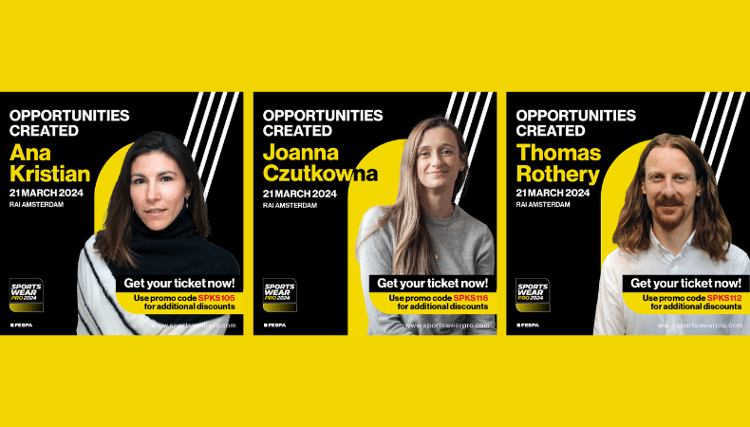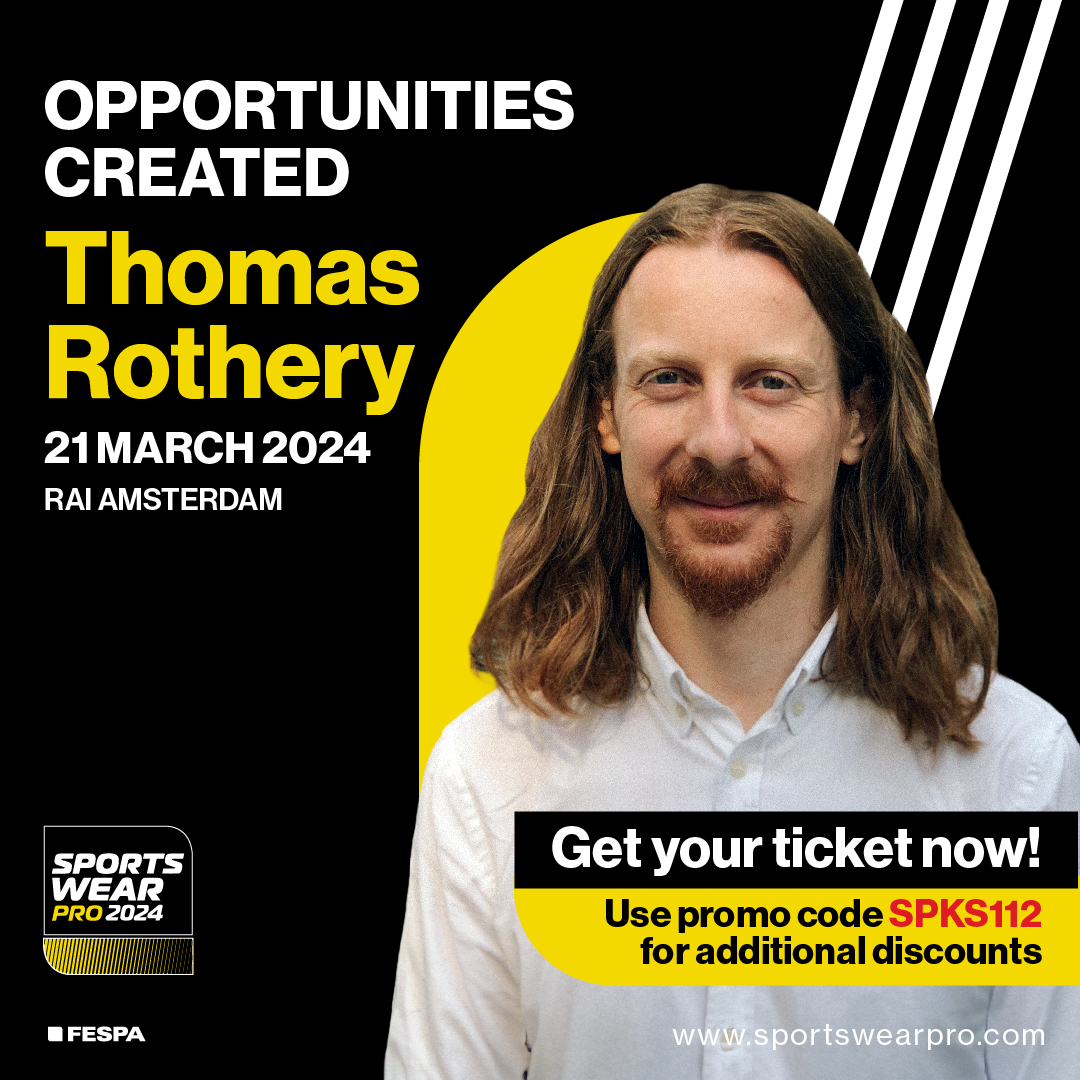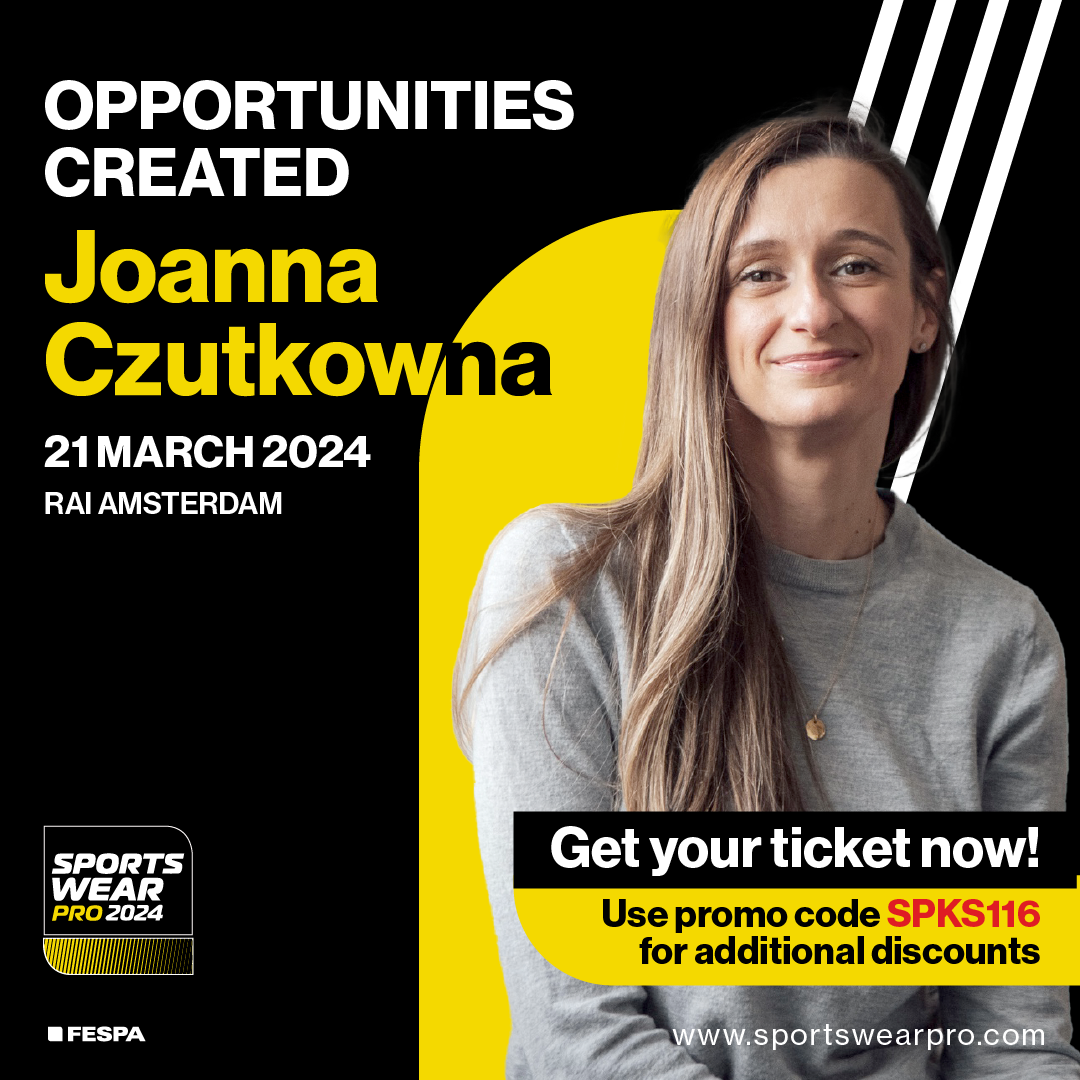Sportswear Pro Conference

Duncan MacOwan, Head of Marketing & Events at FESPA shares details the upcoming Sportswear Pro Conference 2024 taking place on 21st March at the RAI Amsterdam.
In just a few weeks, we’re hosting our first ever Sportswear Pro conference (21 March 2024, Amsterdam RAI, The Netherlands). Delegates will have the opportunity to learn about the latest developments in the sportswear manufacturing industry, as well as cutting-edge innovations used in on demand and customised sportswear production.
In this article, I reflect on my conversations with some of the speakers – Ana Kristiansson, Founder and Creative Director, Desinder; Thomas Rothery, Fashion-Tech Consultant, Copper Global; Joanna Czutkowna, Consultant and Managing Director, 5THREAD. We discuss their background and passion for sportswear, the future of the industry, sustainability and what topics they will be covering in their conference sessions and panels.
Can you tell us a bit more about your background in the sportswear market?
Ana Kristiansson: I’m a former pro athlete and I wanted to combine my passion for fashion and long-lasting sustainable garments with my background in sportswear. That’s why I founded Desinder, a creative agency which specialises in developing strategy, branding, design and communications for sports, outdoor, and lifestyle clothing brands. A key part of what we do is developing strategies for companies who have traditionally relied on having large stocks of their items but need and want to adapt in order to strengthen their business models and better respond to the needs of their customers – all while minimising waste. We also guide brands through the design process of their clothing products, including sourcing materials and manufacturers.
Thomas Rothery: I’ve worked as a menswear designer for over 15 years now, primarily in sportswear, casual wear and high street retail for brands including FILA, where I also led the development of metaverse strategy. This paved the way for a move to fashion-tech consulting to build on my excitement for how we can use modern technological advancements and artificial intelligence (AI) for trend spotting, design and manufacturing. I'm working on a range of different projects at the moment, one of which includes developing a 3D design configurator. I also work with brands and suppliers to help steer them on their digital fashion journey and how they can embrace modern technology.
Joanna Czutkowna: I’m a consultant and doctoral researcher specialising in circularity within sports apparel. With over 20 years of experience managing global sourcing strategy and innovation departments for some of the world's largest brands, I have extensive experience in product innovation and global supply chains. My consultancy business, 5THREAD, helps support organisations as they transition towards more circular business models. Our five core values are circularity, inclusivity, supply chain relationships, digital transformation and leadership. Our clients include: global brands, sports, governing bodies, independent education providers, and innovation and research-led brands. We support them with product innovation and development, sustainability reporting, future-proofing, business strategy for upcoming legislation, supplier relationship management and subject matter expertise.

What’s a trend in sportswear that you’ll be talking about during the conference?
Ana Kristiansson: It’s evident that we’re living in a world where we all – at organisational and individual levels – are striving to incorporate sustainable practices into our daily lives and operations. This includes the fashion and sportswear markets. There are ways that brands can enhance the life and reusability of their sportswear items while supporting the circular economy and limiting waste. For example, imagine if you’ve got a sports sweater and the zipper breaks. To make the garment last as long as possible, it would be great if the customer could easily get a replacement zipper fitted – either by the clothing brand or by doing it themselves with a repair kit provided by the brand – rather than returning and swapping it for an entirely new one. And, in many cases where a new sweater is sent to the customer, the old one is often thrown away which is extremely wasteful. I also always advise brands to consider colouration when designing their products, stocking higher numbers of items where the colour scheme is more classic and long-lasting, and lower stocks where the colour of the item is seasonal.
Thomas Rothery: Thanks to modern technology, there are a lot of ways in which we can make sportswear design and production more efficient and tailored to consumer demand. For me, the importance lies in staying abreast of these new technologies and training your design and development team to act in a much more agile way. Some of these advancements to keep an eye out for are sketch to 3D design software and the increased sophistication of AI for trend forecasting.
I think it’s also important to keep an eye on generative manufacturing and how brands can embrace this to add a new, co-creative customer experience to their offering. Generative manufacturing uses a preset series of rules in code or interaction with AI to quickly generate and optimise a clothing design based on both brand and customer-defined parameters. Especially in gaming, there’s an exciting opportunity to create personalised avatars, and clothing worn by the avatar could be made into physical items which can, in turn, be purchased by the user. The process of implementing 3D designs can strengthen brand loyalty by encouraging consumers to think: “This clothing brand is working with a computer game that I love. I can buy their clothing in real life and digital worlds”.
Joanna Czutkowna: There’s a huge opportunity and need in sportswear manufacturing to promote design for circularity. For me, that goes beyond making the design of the product itself more sustainable by making the materials recyclable or longer lasting. Because then we’re still passing the responsibility to the customer to recycle the garment properly. But if we don't have the infrastructure for that customer to return it somewhere, pass it on or resell it, to extend the product life, we've only done half the job.
Designing for a circular economy isn’t just about designing the product, it’s also about designing the systems that facilitate those circular loops. It’s thinking about what happens when you don't want your clothes anymore. Only 30% of clothes donated to a charity shop, for example, actually end up being sold in the charity shop and a lot of it ends up overseas in second-hand markets in parts of Africa. Brands take very little responsibility for the garment after they pass it to the customer. And that’s really interesting to me, we have enough clothes now for the next six generations, so we definitely need to design clothes in a better way, but we also need to think about the legacy of clothes we've already made.

How do you see the sportswear market changing in light of sustainability demands and government legislation?
Ana Kristiansson: Consumers everywhere are becoming more educated about the fashion and sportswear industry, and they’re questioning supply chains, materials and product lifecycles. Customers didn’t invent fast fashion, so they’re not to blame for 57% of all clothing ending up in landfills [according to Common Objective]. It’s going to become increasingly urgent for brands to support their customers, facilitate more sustainable operations on their part and explain to their customers what they should do with the product when it’s no longer usable. And on top of consumer demand, there’s also new legislation around sustainability, making it imperative for brands to adapt, in order to keep operating and avoid fines.
Thomas Rothery: Something that will hugely impact the fashion and sportswear industry, is the need for digital product passports. There’s a lot of legislation coming that will demand brands to be transparent about their supply chain, material choices and production. And I think that opens up some really exciting opportunities to enrich customer experience. So rather than just having a form completed with supply chain details, you could add QR codes and link our customers to a video showing the design process, or a virtual ‘meet the designer and ‘visit the farm on which the cotton was grown’, for example. The possibilities are endless from a marketing point of view.
Joanna Czutkowna: Based on the upcoming legislation, we’re going to see a big change in recycling infrastructure. We need to start looping back and finding ways to reuse, resell or recycle existing garments. There are some really interesting projects about textile recycling, for example, PUMA is now recycling existing football kits to create new ones. The RE:JERSEY project reuses old sportswear to create yarn for new jerseys. I think the key for brands here will be to switch their business models to keep making revenue, while not overproducing and promoting a fast fashion approach. So, perhaps thinking about whether they can refurbish? Can they repair it? Can they offer customisation? Can they offer digital experiences? Can they offer a rental service?
What will you be covering in your session?
Ana Kristiansson: My session, ‘Circular Economy Redefined – Designing for Circularity’, will explore the twenty-point framework we’ve developed at Desinder to outline how you can design products – including sportswear – to withstand the test of time. I will cover manufacturing, production and circularity across the sportswear supply chain and I’m also going to touch on how you can showcase your sustainable designs and initiatives without ‘greenwashing’.
I’m also joining a panel alongside other speakers about ‘Sportswear Trends Unveiled, A Deep Dive into the European Market’, where we will discuss how brands are embracing (or not) the era of on-demand and customisation and where the future potentially lies, as well as a discussion about ‘Designing for the Circular Economy’.
Thomas Rothery: The brands that embrace a digital mindset and new technologies will be far more agile in the market, getting ahead of the competition. I will be speaking in a panel about ‘AI. Shaping the Future of Sportswear Manufacturing’, where we will delve deeper into AI’s value for trend and demand forecasting, the potential of generative manufacturing, and success stories of brands embracing AI. We will also look at the effects this has on design and efficiency, as well as associated risks to bear in mind.
Joanna Czutkowna: I will be speaking about ‘Designing for the Circular Economy’ where we will explore product life extension and circular design principles to minimise waste. Drawing on my experience of sourcing materials and factories, doing audits, overseeing production and organising shipping, I will explain how the decisions being made in a buying office impact production and customers. I want to discuss how we can take responsibility for the garments produced, as well as extend the product life of existing garments.
Whether you’re a sportswear manufacturer, clothing producer, textile printer or sports apparel designer, we’re inviting you to join us at the inaugural Sportswear Pro conference. Find out how key trends are impacting the industry, connect with experts, learn about the market’s continued growth potential and immerse yourself in the world of sportswear.
For more information on the conference and to register, visit here.
Topics
Interested in joining our community?
Enquire today about joining your local FESPA Association or FESPA Direct
Recent news

The power of digital design tools in screen printing
James Gatica shares how the combination of traditional screen-printing techniques with cutting-edge digital design tools is revolutionising the way designers conceptualise and produce custom decorative pieces.

Key trends and market shifts on Personalisation and Sportswear with Epson
Debbie McKeegan speaks to Duncan Ferguson, VP of Commercial and Industrial Printing at Epson Europe about the market shifts and current trends around personalisation. Duncan shares the key trend of merging both fashion and sportswear.

